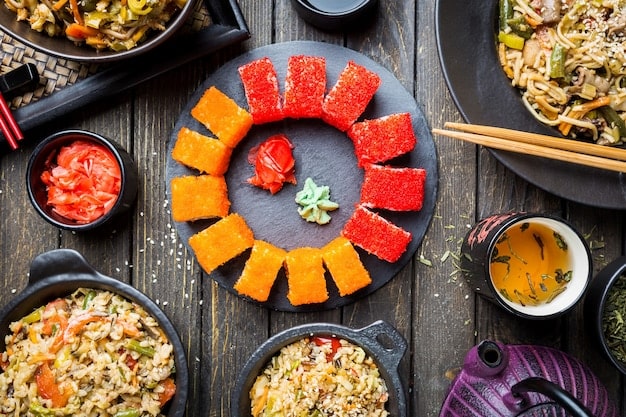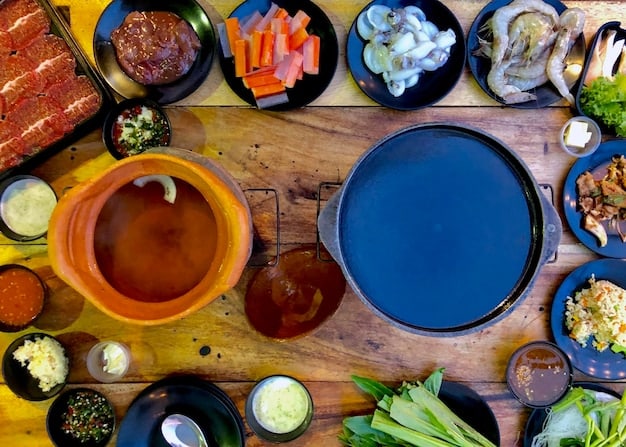Korean Cuisine Trends: What US Foodies Will Love This Year

What’s New in Korean Cuisine Trends for US Foodies This Year? Expect exciting fusion dishes, plant-based Korean food, advanced fermentation techniques and regional specialties gaining prominence, all adapted for the American palate.
Get ready, foodies! **What’s New in Korean Cuisine Trends for US Foodies This Year?** From innovative takes on classic dishes to entirely new culinary experiences, the Korean food scene is set to explode with flavors that will tantalize your taste buds.
Korean Cuisine Evolution: A Taste of Tomorrow
Korean cuisine is more than just kimchi and BBQ; it’s a dynamic culinary landscape constantly evolving. Let’s explore how Korean chefs are pushing boundaries and redefining flavors to captivate the US food scene.
Fusion Frenzy: Where East Meets West
Fusion is key to introducing new flavors. Korean chefs are blending traditional techniques with global ingredients, creating dishes that are both familiar and excitingly new.
- Kimchi Arancini: A playful take on the Italian classic, infused with the spicy, fermented goodness of kimchi.
- Gochujang Glazed Tofu: Crispy tofu coated in a sweet and spicy gochujang glaze, a perfect vegetarian option.
- Black Garlic Noodles: Umami-rich black garlic sauce tossed with chewy noodles, offering a savory delight.
These fusion dishes offer an entry point for those less familiar with Korean cuisine, making it more accessible and appealing.

Plant-Based Korean: Veggie Delights Take Center Stage
With the rise of plant-based eating, Korean cuisine is adapting to offer delicious and innovative vegetarian and vegan options. We’ll unearth the inventive uses of Korean ingredients to create satisfying plant-based menus.
Gone are the days of limited vegetarian options. Korean chefs are embracing plant-based ingredients like never before. From creative uses of tofu to innovative vegetable preparations, the possibilities are endless.
Innovative Tofu Creations
Tofu, a staple in Korean cuisine, is being reimagined in exciting new ways. Marinated, smoked, and fried, tofu can be transformed into a variety of flavorful dishes.
Mushroom Mania
Korean cuisine utilizes a wide array of mushrooms, each offering unique textures and flavors. From shiitake to enoki, mushrooms are used to create rich and savory plant-based dishes.
Plant-based Korean cuisine is not just about removing meat; it’s about celebrating the flavors and textures of vegetables in innovative and exciting ways.
Fermentation Forward: The Art of Flavor Enhancement
Fermentation is at the heart of Korean cuisine, and chefs are now pushing the boundaries of this ancient technique. We’ll explore how innovative fermentation processes are elevating flavors and enhancing health benefits.
Fermented foods are a cornerstone of Korean cuisine, offering not only unique flavors but also numerous health benefits. From classic kimchi to innovative fermented sauces, fermentation is key to unlocking complex flavors.
- Beyond Kimchi: Discovering other fermented vegetables and sauces, like doenjang (fermented soybean paste) and gochujang (fermented chili paste).
- Innovative Fermentation Techniques: Exploring new methods of fermentation and their impact on flavor profiles.
- Health Benefits: Understanding the probiotic benefits of fermented foods and their impact on gut health.
Fermentation is not just a culinary technique; it’s a way of preserving and enhancing flavors while also promoting health and well-being.
Regional Specialties: Unearthing Hidden Culinary Gems
Beyond the well-known dishes, Korea boasts a rich tapestry of regional specialties. We’ll showcase unique dishes from different provinces that are making their way onto US menus, offering a taste of authentic Korean culture.
Korean cuisine is incredibly diverse, with each region offering unique dishes and flavors. From the seafood stews of coastal towns to the hearty soups of mountainous regions, there’s always something new to discover.

- Jeju Black Pork: A prized delicacy from Jeju Island, known for its rich flavor and tender texture.
- Busan Seafood Hotpot: A flavorful and spicy hotpot featuring a variety of fresh seafood, a specialty of the coastal city of Busan.
- Jeonju Bibimbap: A colorful and flavorful rice dish with a variety of vegetables, meat, and a gochujang sauce, a specialty of Jeonju.
Exploring regional specialties offers a deeper understanding of Korean culture and culinary traditions, providing a more authentic and enriching dining experience.
K-Drinks: Pairing Libations for the Perfect Meal
No Korean meal is complete without the right beverage. We’ll delve into the world of Korean drinks, from traditional rice wines to modern craft creations, and discover the perfect pairings for your favorite dishes.
Makgeolli Magic
Makgeolli, a traditional Korean rice wine, is experiencing a resurgence in popularity. Its creamy texture and slightly sweet flavor make it a perfect complement to spicy Korean dishes.
Soju Sophistication
Soju, a clear distilled spirit, is a staple in Korean drinking culture. From classic soju to flavored variations, there’s a soju for every palate.
Pairing K-drinks with Korean cuisine enhances the overall dining experience, creating a harmonious blend of flavors and textures.
DIY Korean: Cooking at Home Made Easy
The allure of Korean cuisine extends beyond restaurants. We’ll provide tips and recipes for recreating your favorite dishes at home, making the experience accessible and enjoyable for everyone.
Bring the flavors of Korea into your own kitchen with easy-to-follow recipes and tips. From making your own kimchi to whipping up a batch of bulgogi, cooking Korean food at home is easier than you think.
Kimchi Chronicles
Learn the basics of kimchi-making and experiment with different variations. With a little practice, you can create your own unique kimchi blend.
Bulgogi Bonanza
Master the art of bulgogi, marinated beef that’s perfect for grilling or stir-frying. This versatile dish is sure to become a family favorite.
Cooking Korean food at home is a rewarding experience that allows you to explore new flavors and techniques, while also creating delicious and healthy meals.
The American Adaptation: Tastes Tailored for the US Palate
While authenticity is key, Korean cuisine is often adapted for the American palate. We’ll discuss how subtle tweaks and flavor adjustments are making Korean food more appealing to US foodies.
To appeal to a wider audience, Korean cuisine is often adapted to suit American tastes. These adaptations may include adjusting spice levels, incorporating familiar ingredients, or offering fusion dishes that blend Korean flavors with Western techniques.
- Spice Level Adjustments: Understanding how spice levels are adjusted to cater to different palates.
- Ingredient Substitution: Exploring how Korean ingredients are sometimes substituted with more readily available alternatives.
- Fusion Dishes: Examining the role of fusion dishes in introducing Korean flavors to American diners.
While authenticity is valued, adaptation plays a crucial role in making Korean cuisine more accessible and enjoyable for US foodies.
| Key Trend | Brief Description |
|---|---|
| 🌱 Plant-Based Korean | Innovative veggie options using tofu and mushrooms. |
| 🌶️ Fusion Cuisine | Blending Korean flavors with international dishes. |
| 🍶 Fermentation | Advanced techniques enhancing flavor and health benefits. |
| 🌏 Regional Specialties | Unique dishes from different Korean provinces gaining popularity. |
Frequently Asked Questions
▼
Korean cuisine stands out due to its extensive use of fermented ingredients, balanced flavors, and integration of traditional cooking methods with modern culinary techniques.
▼
Many Korean dishes do have a spicy kick, thanks to the use of gochujang. However, the level of spiciness can vary, with many milder options available as well.
▼
Popular Korean drinks include Makgeolli, a traditional rice wine, Soju, a clear distilled spirit, and various herbal teas, each offering unique flavors and cultural significance.
▼
Korean cuisine can be very healthy, emphasizes fresh vegetables, lean meats, and fermented foods, which provide probiotics and other beneficial nutrients. Moderation is key.
▼
Korean food is often adapted for American tastes by adjusting spice levels, incorporating familiar ingredients, and creating fusion dishes that blend Korean flavors with Western methods.
Conclusion
From plant-based innovations and fusion dishes to the exploration of regional specialties, Korean cuisine offers a dynamic and exciting culinary journey for US foodies. Whether you’re a seasoned Korean food enthusiast or a curious newcomer, there’s something new and delicious to discover in the ever-evolving world of Korean cuisine.





